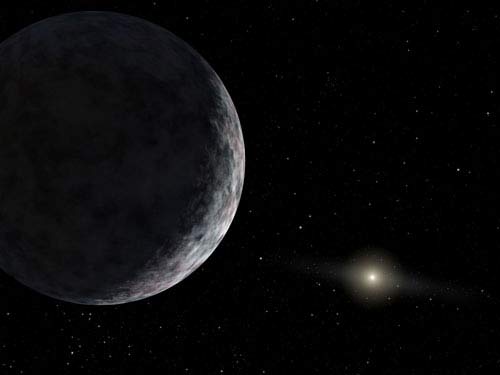Fourth Dwarf Planet Named For Polynesian God

A dwarfplanet circling the sun out beyond the orbit of Neptune has been rechristenedMakemake after a Polynesian god and designated the third of the solar system?snew class of plutoids, the International Astronomical Union (IAU) announcedSaturday.
Makemake is a small, red-tinged world that ranks among the largestobjects in the outer solar system. But it is still smaller and dimmer than the alreadydemoted dwarf planet Pluto, which astronomers reclassifiedas a plutoid last month.
AstronomersdiscoveredMakemake (pronounced MAH-keh MAH-keh), the fourthdwarf planet so far, in 2005 and believe its surface is covered by a layer offrozen methane. It is bright enough to be seen by a high-end amateur telescope,the IAU said.
?The orbitis not particularly strange, but the object itself is big,? said astronomerMike Brown of the California Institute of Technology in Pasadena, Calif., wholed the team that discovered Makemake. ?Probably abouttwo-thirds the size of Pluto.?
Pluto,Makemake and a third object - dubbed Eris - are all classifiedas plutoids, as well as dwarf planets. The solar system?s largest asteroidCeres is also a dwarf planet, but not in the plutoid class because its orbit,which falls in the belt of asteroids between Mars and Jupiter, is smaller thanthat of the more distant Neptune.
Originallydesignated 2005 FY9, the object was nicknamed ?Easterbunny?by its discoverers before officially being named Makemake after the Polynesiancreator of humanity and the god of fertility, the IAU said.
?Weconsider the naming of objects in the solar system very carefully,? said Brown.
Get the Space.com Newsletter
Breaking space news, the latest updates on rocket launches, skywatching events and more!
Makemake?smethane ice-rich surface, while fascinating, did not easily relate to Earthlymythology, he added. But the small dwarf planet, like Eris and the object 2003EL61 also spotted by Brown and his team, was found while his wife was pregnantwith their daughter. It was the discovery of those three objects that led toPluto?s dropfrom full planet to dwarf planet in 2006.
Brown wasresearching the mythology of Rapa Nui, or Easter Island, in the South Pacificfor prospective names when he learned of the creator and fertility godMakemake.
?I ampartial to fertility gods,? Brown said, recalling the discovery of Makemake,Eris and 2003 EL61. ?I have the distinct memory of feeling this fertileabundance pouring out of the entire Universe. Makemake was part of that."
- Video: Passport to Pluto
- The History of the Pluto Controversy
- Gallery: Our New Solar System
Join our Space Forums to keep talking space on the latest missions, night sky and more! And if you have a news tip, correction or comment, let us know at: community@space.com.

Space.com is the premier source of space exploration, innovation and astronomy news, chronicling (and celebrating) humanity's ongoing expansion across the final frontier. Originally founded in 1999, Space.com is, and always has been, the passion of writers and editors who are space fans and also trained journalists. Our current news team consists of Editor-in-Chief Tariq Malik; Editor Hanneke Weitering, Senior Space Writer Mike Wall; Senior Writer Meghan Bartels; Senior Writer Chelsea Gohd, Senior Writer Tereza Pultarova and Staff Writer Alexander Cox, focusing on e-commerce. Senior Producer Steve Spaleta oversees our space videos, with Diana Whitcroft as our Social Media Editor.









